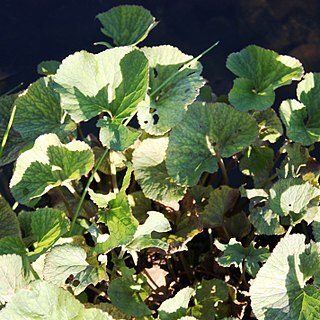Herb 15–100 cm. tall.. Rhizome often deep red or yellow, up to about 2.2 cm. thick.. Leaves with robust petiole 15–80 cm. long, sparsely pubescent to glabrous; limb reniform to almost round, broader than long, 4–15(–24) cm. long, 5.5–26.5(–30) cm. wide, cordate at the base, toothed, pubescent to quite densely almost scabrid-velvety hairy with stiff adpressed hairs particularly on the nerves and in the young state, becoming glabrescent.. Spikes solitary or fasciculate, sparsely to densely arranged along an axis (15–)25–100(–150) cm. long of which the peduncle, often red at the base, comprises 2–35 cm.; spikes 0.2–13.5 cm. long, the basal ones the longest, many-flowered, sparsely pubescent to glabrous; bracts elliptic-lanceolate to linear, 4–8 mm. long, ± pubescent or glabrous.. Flowers ♂, ♀ or hermaphrodite, pink or pale violet; calyx-tube green, 0.5–1.5 mm. long, lobes reddish, triangular, minute; petals reddish brown, ± linear-spathulate, 2–3.6 mm. long, glabrous or hairy at the apex, sometimes absent; anthers 1–1.9 mm. long; styles subulate, plumose, (0.4–)0.9–1.4 mm. long, or rudimentary or absent.. Fruits sessile, subsessile or slightly pedicellate, globose, 1 mm. in diameter, glabrous, with bases of calyx-lobes and stamens persistent.. Fig. 1.
Perennial herb, 0.3-1.5 m high; nearly stemless, mainly rhizomatous, usually associated with water. Leaves radical, alternate, simple, long-petioled, ovate-to orbicular-cordate, entire, lobed or crenate; stipules adhering to petioles. Flowers unisexual or bisexual, small, in compound spikes, sometimes with male flowers above and female below. Calyx 2-or 3-lobed, sometimes absent, or imperfect in male flowers. Petals (0)2, small, concave. Stamens 1 or 2; anthers oblong, basifixed, longer than filaments. Ovary inferior, 1-locular, ovule solitary, pendulous; styles 2, papillose. Flowering time Oct.-Feb. Fruit a fleshy or leathery drupe, compressed, 3-angled or subglobose.
Flowers male, female and hermaphrodite, ebracteolate; calyx-tube urceolate; calyx-lobes minute, triangular; petals c. 2 mm. long, linear-spathulate, glabrous or hairy at apex, caducous, or absent; stamens with anthers up to 1·5 mm. long, broadly ellipsoid, dorsiventrally compressed, and filaments c. 0·4 mm. long, or absent; styles up to 1 mm. long, filiform, plumose from the base, divergent, or rudimentary or absent.
Leaves robust, tufted near the apex of rhizome; leaf-lamina 4–13(25) x 6–17(38) cm., reniform to subcircular, palmately nerved, margin irregularly dentate with glandular teeth, cordate at the base, appressed-hairy on both surfaces, particularly so beneath and along the nerves when young, glabrescent with age; petiole 15–75 cm. long, stout, appressed-hairy to glabrescent.
A fleshy perennial herb. It forms suckers. It does not have a stem above ground. The leaves arise from the ground. The leaves are large and kidney shaped and 30 cm across. The leaf stalks are 60 cm long. The flowering stalk arises from the ground. It can be 90 cm high. The flowers are small and coppery-red in open sprays. The fruit are somewhat fleshy.
Spikes (0·5)2–7(10) cm. long, slender, sparsely hairy, solitary or fasciculate, remotely to densely disposed usually only along the upper 3/4 of scape, subtended by 4–10 mm. long triangular to linear and usually pubescent bracts; scapes usually solitary at the apex of rhizome, sparsely hairy or glabrescent, usually exceeding leaves.
Rhizomatous herb, up to 1 m high. Leaves robust; blade 40-130(-250) x 60-170(-380) mm, reniform to subcircular, palmately nerved, margins irregularly dentate, teeth glandular at apices; petioles 150-750 mm long. Flowers: spikes (5-)20-70(-100) mm long; corolla green to reddish; Oct.-Mar.
Rhizomatous herb, up to 1 m high. Leaves robust, lamina 40-130(-250) x 60-170(-380) mm, reniform to subcircular, palmately nerved, margin irregularly dentate with glandular teeth; petiole 150-750 mm long. Spikes (5-)20-70(-100) mm long. Flowers green to reddish; October to March.
Monoecious, dioecious or polygamous, rhizomatous perennial to 1 m, thinly hairy. Leaves tufted, round or kidney-shaped on long petioles, toothed. Flowers sessile in spike-like racemes, greenish.
Drupelets c. 1·4 mm. in diameter, subglobose, slightly laterally compressed and thus ± 2-crested, glabrous, crowned by the calyx-lobes, sessile or on pedicels up to 1 mm. long.
Rhizomatous herb, up to 1 m. tall; rhizome ± elongated, usually creeping, up to 3 cm. thick, yellow-fleshed.


